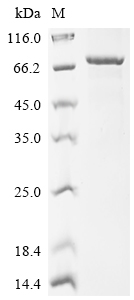Recombinant Human Sphingomyelin phosphodiesterase (SMPD1)
CAT:
399-CSB-EP021845HUa2-02
Size:
100 µg
Price:
Ask
- Availability: 24/48H Stock Items & 2 to 6 Weeks non Stock Items.
- Dry Ice Shipment: No




Recombinant Human Sphingomyelin phosphodiesterase (SMPD1)
- CAS Number: 9000-83-3
- Gene Name: SMPD1
- UniProt: P17405
- Expression Region: 47-631aa
- Organism: Homo sapiens
- Target Sequence: LALSDSRVLWAPAEAHPLSPQGHPARLHRIVPRLRDVFGWGNLTCPICKGLFTAINLGLKKEPNVARVGSVAIKLCNLLKIAPPAVCQSIVHLFEDDMVEVWRRSVLSPSEACGLLLGSTCGHWDIFSSWNISLPTVPKPPPKPPSPPAPGAPVSRILFLTDLHWDHDYLEGTDPDCADPLCCRRGSGLPPASRPGAGYWGEYSKCDLPLRTLESLLSGLGPAGPFDMVYWTGDIPAHDVWHQTRQDQLRALTTVTALVRKFLGPVPVYPAVGNHESTPVNSFPPPFIEGNHSSRWLYEAMAKAWEPWLPAEALRTLRIGGFYALSPYPGLRLISLNMNFCSRENFWLLINSTDPAGQLQWLVGELQAAEDRGDKVHIIGHIPPGHCLKSWSWNYYRIVARYENTLAAQFFGHTHVDEFEVFYDEETLSRPLAVAFLAPSATTYIGLNPGYRVYQIDGNYSGSSHVVLDHETYILNLTQANIPGAIPHWQLLYRARETYGLPNTLPTAWHNLVYRMRGDMQLFQTFWFLYHKGHPPSEPCGTPCRLATLCAQLSARADSPALCRHLMPDGSLPEAQSLWPRPLFC
- Tag: N-terminal 6xHis-SUMO-tagged
- Source: E.coli
- Field of Research: Neuroscience
- Assay Type: Developed Protein
- Relevance: Converts sphingomyelin to ceramide. EXIsts as two enzymatic forms that arise from alternative trafficking of a single protein precursor, one that is targeted to the endolysosomal compartment, whereas the other is released extracellularly. However, in response to various forms of stress, lysosomal exocytosis may represent a major source of the secretory form. ; In the lysosomes, converts sphingomyelin to ceramide. Plays an important role in the export of cholesterol from the intraendolysosomal membranes. Also has phospholipase C activities toward 1, 2-diacylglycerolphosphocholine and 1, 2-diacylglycerolphosphoglycerol. Modulates stress-induced apoptosis through the production of ceramide. ; When secreted, modulates cell signaling with its ability to reorganize the plasma membrane by converting sphingomyelin to ceramide. Secreted form is increased in response to stress and inflammatory mediators such as IL1B, IFNG or TNF as well as upon infection with bacteria and viruses. Produces the release of ceramide in the outer leaflet of the plasma membrane playing a central role in host defense. Ceramide reorganizes these rafts into larger signaling platforms that are required to internalize P. aeruginosa, induce apoptosis and regulate the cytokine response in infected cells. In wounded cells, the lysosomal form is released extracellularly in the presence of Ca (2+) and promotes endocytosis and plasma membrane repair. ; [Sphingomyelin phosphodiesterase, processed form]: This form is generated following cleavage by CASP7 in the extracellular milieu in response to bacterial infection. It shows increased ability to convert sphingomyelin to ceramide and promotes plasma membrane repair. Plasma membrane repair by ceramide counteracts the action of gasdermin-D (GSDMD) perforin (PRF1) pores that are formed in response to bacterial infection. ; (Microbial infection) Secretion is activated by bacteria such as P. aeruginos, N. gonorrhoeae and others, this activation results in the release of ceramide in the outer leaflet of the plasma membrane which facilitates the infection. ; (Microbial infection) Secretion is activated by human coronaviruses SARS-CoV and SARS-CoV-2 as well as Zaire ebolavirus, this activation results in the release of ceramide in the outer leaflet of the plasma membrane which facilitates the infection. ; [Isoform 2]: Lacks residues that bind the cofactor Zn (2+) and has no enzyme activity. ; [Isoform 3]: Lacks residues that bind the cofactor Zn (2+) and has no enzyme activity.
- Purity: Greater than 90% as determined by SDS-PAGE.
- Activity: Not Test
- Length: Full Length of Mature Protein
- Form: Liquid or Lyophilized powder
- Buffer: If the delivery form is liquid, the default storage buffer is Tris/PBS-based buffer, 5%-50% glycerol. If the delivery form is lyophilized powder, the buffer before lyophilization is Tris/PBS-based buffer, 6% Trehalose, pH 8.0.
- Reconstitution: We recommend that this vial be briefly centrifuged prior to opening to bring the contents to the bottom. Please reconstitute protein in deionized sterile water to a concentration of 0.1-1.0 mg/mL.We recommend to add 5-50% of glycerol (final concentration) and aliquot for long-term storage at -20℃/-80℃. Our default final concentration of glycerol is 50%. Customers could use it as reference.
- Molecular Weight: 78.2 kDa
- References & Citations: "Regulated secretion of acid sphingomyelinase: implications for selectivity of ceramide formation." Jenkins R.W., Canals D., Idkowiak-Baldys J., Simbari F., Roddy P., Perry D.M., Kitatani K., Luberto C., Hannun Y.A. J. Biol. Chem. 285:35706-35718 (2010)
- Storage Conditions: The shelf life is related to many factors, storage state, buffer ingredients, storage temperature and the stability of the protein itself. Generally, the shelf life of liquid form is 6 months at -20℃/-80℃. The shelf life of lyophilized form is 12 months at -20℃/-80℃.
